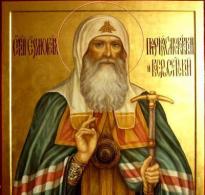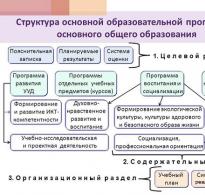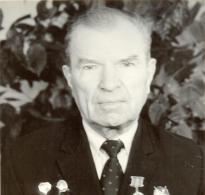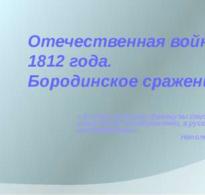The village of Radonezh, Moscow region. Radonezh Compound of the Holy Trinity Sergius Lavra - Church of the Transfiguration of the Lord, village of Radonezh Radonezh where
Radonezh is a place that tourists usually visit on their way to the Trinity-Sergius Lavra. It is inextricably linked with St. Sergius, and extraordinary beauty reigns there. Wooden stairs, paths, a monument, a temple, springs - all this is very harmoniously combined.
The village of Radonezh is located on the left bank of the Pazhi River. It is famous for the fact that the saint’s family settled here (parents Kirill and Maria, brothers), who moved from Rostov the Great. And here the exploits of this saint began. After the death of his parents, then Bartholomew began a monastic life.
Church of the Transfiguration of the Lord
We are approaching the Church of the Transfiguration of the Lord. It was built at the expense of parishioners and benefactors in 1836-1842. In general, Radonezh, so to speak, is dedicated to St. Sergius: in the temple there are paintings depicting episodes from the life of the saint; monument, sources in honor of him. 
Temple interior:



Painting based on the painting by V.M. Nesterov “Vision to the Youth Bartholomew.” The plot was taken from the life of St. Sergius:
“One day my father sent Bartholomew to the field to fetch horses. On the way, he met an Angel sent by God in a monastic form: an old man stood under an oak tree in the middle of a field and prayed. Bartholomew approached him and, bowing, began to wait for the end of the elder’s prayer. He blessed the boy, kissed him and asked what he wanted. Bartholomew replied: “With all my soul I wish to learn to read and write, Holy Father, pray to God for me, so that He will help me learn to read and write.” The monk fulfilled Bartholomew’s request, raised his prayer to God and, blessing the youth, said to him: “From now on, God gives you, my child, to understand literacy, you will surpass your brothers and peers.” At the same time, the elder took out a vessel and gave Bartholomew a piece of prosphora: “Take it, child, and eat it,” he said. “This is given to you as a sign of God’s grace and for the understanding of Holy Scripture.”  Painting in the temple based on the painting by V.M. Nesterov “Vision to the Youth Bartholomew”
Painting in the temple based on the painting by V.M. Nesterov “Vision to the Youth Bartholomew”
Children's playground near the temple:
 Children's playground near the temple
Children's playground near the temple Let's go to the chapel of the blessed Matrona of Moscow following the sign. In the chapel there is a cross that stood on the saint’s grave.
 Chapel of the Blessed Matrona of Moscow
Chapel of the Blessed Matrona of Moscow On the opposite side of the chapel is the source of St. Sergius of Radonezh. To get to it, you have to go down the wooden steps.
And along the way, let’s pay attention to the monument to St. Sergius, designed by sculptor V.M. Klykov and architect R.I. Semerzhiev (1988). The monument represents the figure of an elder in a monastic robe, his hands folded prayerfully at his chest. In the middle is the figure of the boy Bartholomew with the icon of the Trinity in his hands. Inscription: “Russia is grateful to Sergius of Radonezh.”  Monument to St. Sergius of Radonezh
Monument to St. Sergius of Radonezh
Radonezh is a very picturesque place. We met the Italians on the wooden platform; they set the table and relaxed, enjoying nature.  Staircase to the source
Staircase to the source
On the way down you can have a snack in a cafe. It was closed when we arrived. When you climb the stairs, this beauty will appear before your eyes: 
Here you can plunge into the icy waters of the spring.
 Source of St. Sergius of Radonezh
Source of St. Sergius of Radonezh  Source of St. Sergius of Radonezh.
Source of St. Sergius of Radonezh. Lake of All Saints, built in 2016 with the blessing of Bishop Theognost. 

Historically and geographically, it is best to explore Khotkovo, Radonezh, Deulino and the Trinity-Sergius Lavra at once. Geographically, because all this is relatively nearby, and historically, because the parents of Sergius of Radonezh lived in Radonezh, founded a monastery in Khotkovo, and were buried there, and Sergius of Radonezh was the founder of the Trinity-Sergius Lavra. And in the village of Deulino a peace treaty was signed, which marked the end of the Polish-Lithuanian intervention, the so-called. "Deulin world"
I have already described trips to the Lavra and the Khotkovsky Monastery (see links at the end of the story), now it’s the turn of Radonezh and Deulin. The Land of Radonezh is generally rich in history, bloody battles were fought on it, intrigues were woven, it suffered greatly from many wars, but was revived again.
It is a pity that in Radonezh only the Church of the Transfiguration of the Lord, built in the 19th century, and the memorial sign to Sergius of Radonezh have been preserved - a place for obligatory photography of local newlyweds, but once there were churches, a well-fortified fortress, and multi-meter ramparts, and on one The Khovansky princes, executed by the first Romanov on charges of treason, were buried from the city cemeteries...
Radonezh Church of the Transfiguration of the Lord
When you drive from Khotkovo by car (and we also got there right on Trinity Sunday), on a high hill among an endless green plain you first see many, many cars, and only then a church. It was built in 1836-42. at the expense of parishioners. I will not bore you with a description of the church from an architectural point of view, I will only say that the building is white (previously it was pale blue) in color and has a fairly traditional architecture for churches of that time; a three-tier bell tower is attached to the church on one side, and a refectory on the other .
A fairly strong wind was blowing, it was sunny, but a thundercloud was approaching, so for a walk around the neighborhood I wrapped myself in a jacket with a hood, put on a scarf (it was a holiday after all) and dark glasses. I had a good view.
Right at the entrance there was a store where, in addition to icons, crosses, oils, and candles, for some reason they sold bags, belts, and other rubbish. I had to squeeze between two large counters. It was quite elegant inside: there was green, freshly cut grass on the floor, and near the especially significant icons there were cut down young birch trees in three-liter jars. The wedding had just ended, and the happy newlyweds were standing in the corner. True, at first I thought that the baptism had ended, but at the entrance we saw a car with rings on the roof, and we realized what it was.
In the altar part of the church there is a five-tier iconostasis, in the chapel of St. Sergius of Radonezh there is a two-tier iconostasis. This chapel was built on the very spot where the house of the parents of Sergius of Radonezh stood in the 15th century. The icons for the church were painted by local artists in the 19th century. In some places, wall paintings have been preserved, and in the corner there is a life-size copy of “The Appearance to the Youth Bartholomew” (the original can be seen in the Tretyakov Gallery).
Near the church there is a wooden cross, moved here from Moscow - from the grave of St. Matryona of Moscow. Behind the church fence, right next to the road, there are several old graves overgrown with grass. At some distance there is a memorial sign to Sergius of Radonezh.
It’s worth going down to get water from the source, at least that’s what we went there for. We go down a rather steep staircase, examine the tiny wooden chapel, and then follow the path to the source. About 50 people were already crowded here, most with five-liter plastic tubs.
The source consists of 2 streams of water flowing directly from two metal pipes going into the ground, and one bottle takes quite a long time to fill - in any case, when in my presence one lady asked to fill a small bottle without a queue, she was not allowed in with an angry shout, that, they say, we’ve all been standing here for more than an hour. We didn’t stand, I just jumped around, filming the Pazhu River, densely overgrown with vegetation, and we stomped back. The places are most beautiful - it’s not for nothing that Vasnetsov painted from life here.
Memorial sign to St. Sergius of Radonezh
In 1988, on the outskirts of the village on a low rounded hill, a memorial sign to St. Sergius of Radonezh was erected (sculptor V.M. Klykov, architect R.I. Semerzhiev).
"On its flat top, a three-meter-tall figure of an old man in a monastic robe froze. The half-lowered head of the monk is covered with a doll pulled down on his forehead. The old man's eyes are closed, his hands are prayerfully folded on his chest. In the middle part of the figure, the stone is slightly selected and the figure of the boy Bartholomew protrudes from the outlined elongated niche. He dressed in an untucked shirt and soft trousers tucked into onuchi. The boy has bast shoes on his feet. With wide open eyes, Bartholomew looks over the Radonezh hills. In his hands he holds a carved icon, in the center of which, in a circle, lies a parallelepiped. with the inscription: “Russia is grateful to Sergius of Radonezh.”
Historical reference
Most likely, Radonezh was founded in the 11th century as a Slavic settlement, and its name is the possessive form of the personal Slavic name Radoneg. It is believed that the name of the neighboring city of Khotkovo comes from the name Khotoneg or Khotobug.
At various times, Radonezh was part of the Rostov-Suzdal, and then the Vladimir principalities, and when Rus' fell under the rule of the Golden Horde, the khan's governors sat in Radonezh, collecting tribute, which indicates its importance. In the 14th century, the city became part of the Moscow Principality.
In 1332 (according to other sources - in 1328) the Rostov boyar Kirill moved to Radonezh with his wife Maria and sons Stephon and Bartholomew. The second son is destined to become one of the greatest priests of Rus' named Sergius of Radonezh... The boyar and his wife founded the Intercession Monastery in Khotkovo in the 1330s, which stands there to this day, and in 1342 the sons of the boyar went to the Kochura River near Radonezh and They founded a hermitage there, where Bartholomew took monastic vows on October 7, 1342 (according to other sources - October 7, 1337). The first abbot of the expanding Trinity Monastery was Hegumen Mitrofan, abbot of the Intercession Monastery, who took the tonsure of Sergius of Radonezh.
It was thanks to him that all the princes united before the Battle of Kulikovo, recognizing the supremacy of Dmitry Donskoy. According to legend, Sergius of Radonezh blessed Dmitry Ivanovich Donskoy for the Battle of Kulikovo, after which the appanage Serpukhov prince Dmitry became the great Russian prince. The icon with which the blessing was performed is now kept in the Tretyakov Gallery, and the Donskoy Monastery in Moscow is named after it (I have a separate story about it).
The elder predicted victory for the prince and gave help to the monks Alexander Peresvet and Andrei Oslyabya, whom he himself tonsured into the schema (remember the famous painting “The Duel of Peresvet with Chelubey”?). The biography of St. Sergius tells that the saint saw in the spirit the entire course of the battle, knew the names of the dead soldiers, for whom he himself immediately served a memorial service. In 1389, Dmitry Donskoy invited St. Sergius to seal a spiritual testament that legitimized the new order of succession to the throne from father to eldest son.
The Monk Sergius died on September 25, 1392. After 30 years, his relics and clothes were found incorrupt, and in 1452 (according to other sources - in 1422) he was canonized. The relics of the saint are kept in the Trinity-Sergius Lavra.
In 1613, Mikhail Fedorovich Romanov (1596-1645) was elected Russian Tsar. But Poland did not recognize him as king, and in April 1617, the son of King Sigismund III of Poland, Prince Vladislav, marched with troops to Moscow. The so-called Time of Troubles began. It was during these years that Radonezh and its surroundings were completely devastated.
Trinity-Sergius Monastery, founded in the mid-16th century. powerful fortress walls, was subjected to a 16-month siege by the troops of False Dmitry II, but did not surrender. The misadventures of the monastery did not end there: in 1617, the Polish prince Vladislav, after an unsuccessful assault on Moscow, tried to capture the monastery for the second time, but by this time the abbot of the monastery had acquired his own archers and gunners. The prince moved further along the road to the village of Rogachevo and began negotiations, because frosts were approaching, and the Polish army was exhausted. The Poles, through parliamentarians, announced the cessation of hostilities and the desire for peace with Moscow.
“On the night of November 19-20, Moscow ambassadors led by boyar Fyodor Ivanovich Sheremetev arrived at the Trinity-Sergius Monastery. On the Polish side, the ambassadors were Prince Novodvorsky (hehe!), Hetman Lev Sapega and headman Alexander Gonsevsky. The Poles sought to negotiations were conducted within the walls of the fortress, intending to explore its fortifications. But the Russian ambassadors insisted that the place of negotiations be with Deulino. On December 1, 1618, the ambassadors signed a truce agreement between Russia and the Polish-Lithuanian Commonwealth for 14 and a half years. The agreement was included under the name Deulinsky."
The Transfiguration Church was built in 1836-1842. The base is a pillarless quadrangle, topped with a rotunda with eight windows. There is one apse in the eastern wall of the temple; porticoes with four Doric columns adjoin it on the northern and southern sides. On the west side, a refectory was attached to the temple, since the 1860s it was connected by a narrow passage with a three-tier bell tower that had previously stood separately. In 1855 a fence was built around the church
Monument to St. Sergius of Radonezh
One of the most striking local attractions is the monument to St. Sergius of Radonezh. It was created according to the design of sculptor V.M. Klykov and architect R.I. Semerzhiev and installed next to the temple on May 29, 1989 - in honor of the 1000th anniversary of the Baptism of Rus' and in honor of the 600th anniversary of the repose of St. Sergius here, opposite the temple Transfiguration. This is the first monument to a Russian saint since 1917.
"On its flat top, a three-meter-tall figure of an old man in a monastic robe froze. The half-lowered head of the monk is covered with a doll pulled down on his forehead. The old man's eyes are closed, his hands are prayerfully folded on his chest. In the middle part of the figure, the stone is slightly selected and the figure of the boy Bartholomew protrudes from the outlined elongated niche. He dressed in an untucked shirt and soft trousers tucked into onuchi. The boy has bast shoes on his feet. With wide open eyes, Bartholomew looks over the Radonezh hills. In his hands he holds a carved icon, in the center of which, in a circle, lies a parallelepiped. with the inscription: “Russia is grateful to Sergius of Radonezh.”



Chapel of the Blessed Matrona of Moscow
Next to the temple, the chapel of the blessed Matrona of Moscow was built, in which there is an unusual cross that once stood on the grave of the holy blessed old woman.



Ramparts of the 15th century.
Nowadays there is a cemetery on the territory of the former Detinets.

In the village The Radonezh youth Bartholomew (Sergius of Radonezh) lived for seven years. The name of St. Sergius of Radonezh reminds us to what heights our land, enlightened by the Word of Christ, is capable of rising. A man who did not leave behind a single book stands at the beginning of all Russian culture of the Moscow period, opens the door leading from the remote taiga near Moscow directly into the depths of God's wisdom, into all the secrets of man and the world. And his activity seems all the more miraculous to us because we cannot share in it the fruits of heavenly help and his own labors. All his life Sergius tried to escape from the world, not to take upon himself the decisions of the destinies of the people around him, not to interfere arbitrarily in the events taking place around him. However, all the everyday and historical details of the era are so closely intertwined in his life that, it seems, there is no side of Russian life of the second half of the 14th century that he would not sanctify, where traces of his careful blessing would not remain. If we remember what this time was like, it turns out that St. Sergius stands not only at the beginning of the Russian Enlightenment, but also marks the Russian Renaissance in its highest sense. The spring located here is named after him.



Chapel in honor of the Kazan Icon of the Mother of God
A weak spring consecrated in the name of the Most Holy Theotokos Icon of Kazan is located a kilometer from the road leading to the village of Radonezh. The holy spring is equipped, the water outlet is at the wall of the bathhouse from the side of the stairs. Draining spring water through a metal pipe from a brick retaining wall near a small depression. Entering the road into a field, in dry weather, that’s all. The plunge pool is equipped for swimming in the cold season
The road to the chapel passes through a field. In rainy times, it is better to leave the car at the exit of the road so as not to get stuck and have the opportunity to walk and enjoy the beauty and spaciousness of the landscape.
At the exit from the road there is a sign indicating the way to the chapel and bathhouse.



Village of Radonezh on the left bank of the Pazhi River is one of the oldest settlements in the Sergiev Posad region. It was founded by the Slavs around the 11th century. This is confirmed by the name Radonezh - a personal Slavic name Radonegzh possessive form.
In the middle of the 12th century, Radonezh became part of the Rostov-Suzdal Principality, and at the beginning of the 13th century - part of the Grand Duchy of Vladimir. After the Tatar-Mongol invasion of 1237-1240, the Khan's Baskaks lived here, who monitored the territory entrusted to them and collected tribute. The memory of this is preserved by the names of the wastelands - Khanskaya and Baskakova.
Temple in honor of the Transfiguration of the Lord
Towards the middle of the 14th century, Radonezh became part of the Moscow Principality. And in the village there grew a large estate with the Church of the Nativity of Christ. In 1328, the Rostov boyar Kirill, the father of St. Sergius of Radonezh, moved to Radonezh with his family. Later, Kirill and Maria took monastic vows at the nearby Khotkovo Monastery.
The names of many famous people are associated with the Radonezh land. The first Kazan Archbishop Gury (+ December 4, 1563) and, as historians believe, the brilliant icon painter Andrei Rublev came from these places. Radonezh did not inspire the writer Sergei Aksakov and the famous artists Mikhail Nesterov and Viktor Vasnetsov.

M. Nesterov. Appearance to the youth Bartholomew
In 1410, Radonezh turned into a town with a fortress, earthen ramparts and three churches and became the capital of an appanage principality owned by Prince Andrei Menshoi. The cathedral church of the fortress was called Preobrazhensky.
Tsar Ivan III transferred the fair, which took place in the Trinity Monastery, to Radonezh, and in 1505 he bequeathed the city to his son Vasily. During the Polish-Lithuanian invasion, the Radonezh town, or simply the Town, was completely destroyed. In 1616, Tsar Mikhail Fedorovich transferred it to the Trinity-Sergius Monastery. The monks converted the fortress tower into a tented temple and consecrated it in honor of the Transfiguration of the Lord. A century and a half later, these lands again went to the state.
The new stone Church of the Transfiguration with the chapel of St. Sergius of Radonezh in the refectory was built at the expense of parishioners in 1836-1842. It is considered one of the best examples of Empire style architecture. The creation of the project is attributed to the architect A.G. Grigoriev. In 1854, the temple was surrounded by a fence with corner towers. At first it stood separately from the three-tier bell tower, but in the 1860s they were combined with a refectory. Seven bells were installed on the belfry. The largest of them weighed more than three tons. The temple was decorated with two iconostasis: a five-tiered one in the main part and a two-tiered one in the chapel.
During Soviet times, the Transfiguration Church was closed. In 1941, a club moved here. Later, in the 1960s, the Soviet authorities decided to preserve the Radonezh monuments. In 1974, the temple was given state protection and restored. For the next two decades, the Zagorsk State Museum-Reserve housed within its walls an exhibition dedicated to the history of Radonezh.
One of the most striking local attractions is the monument to St. Sergius of Radonezh. It was created according to the design of sculptor V.M. Klykov and architect R.I. Semerzhiev and installed next to the temple on May 29, 1989. Just a few months later, by decree of the Presidium of the Supreme Council of the RSFSR, the village of Gorodok was renamed Radonezh. In the 1990s, the Church of the Transfiguration was returned to the Orthodox Church. Now this is the courtyard of the Trinity-Sergius Lavra. It is headed by Abbot Sebastian.

Fragments of paintings from the 1870s have been preserved in the temple. Now the frescoes and iconostasis have been restored. An unusual cross has been installed opposite the entrance to the temple. Once upon a time it stood on the grave of the Holy Blessed Matrona of Moscow. Below, under the mountain, at the spring of St. Sergius, two fonts were built.
The most convenient way to get to the village of Radonezh is by car. But you can also take the train on the Yaroslavl railway. From the Radonezh station to the Transfiguration Church on foot - 4 kilometers.





